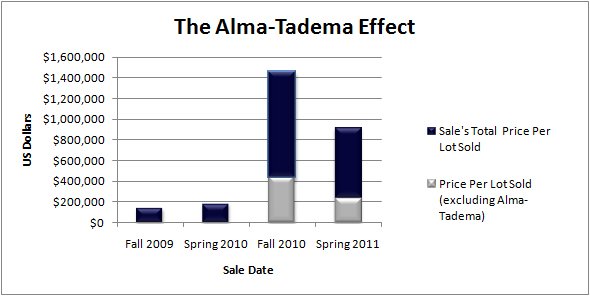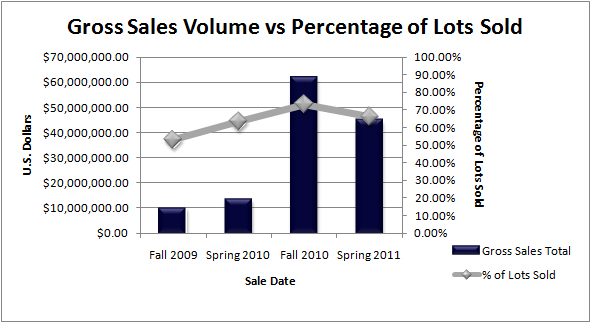COMMENTS ON THE ART MARKET
An Early Report
I know it is not the end of the month, but there will be so much activity in the public forum in May that I thought I would give an interim detailed report on the sale that would probably have the most interest to our readers … the 19th century sale in New York.
While I normally condense these reports into one newsletter I must tell you that I was/am a little upset that the general press barely covered the results from this sale; and since I know that my reports are, at times, picked up by other web sites maybe a wider number of people will get this message.
____________________
The 19th Century Sales
“Watch Me Pull A Rabbit Out Of My Hat!”
Yes, there was some sort of magic going on here and now I really want to know where they buy their magic hats! The top lot from a week that included the major Impressionist and Modern works of art was not a Picasso, Monet or Giacometti, but a 19th century painting! Yes, once again the 19th century showed that we can play this game … and just like the November sale, Sir Lawrence Alma-Tadema blew all the others away (ok, in November an Alma-Tadema was the third most expensive work – Modigliani and Matisse were 1 and 2, but still…).
Before we get started, I must tell you that I was not very impressed with the Alma-Tadema --The Meeting of Antony and Cleopatra: 41 B.C. It was not as large nor as impressive as The Finding of Moses which made $36M in November; but there were two determined bidders (I am wondering if they were the two under bidders on the Moses piece) who battled it out and brought this aggressively estimated work ($3-$5M) to a level nobody in their right mind would have ever expected -- $29M! Yes, that was $29M … more than Steve Cohen’s Vlaminck or Monet’s Les Peupliers (the two top lots in the Impressionist/Modern sales that each made a paltry $22.48M). So who’s boss now!?
As I stated earlier, I was disappointed (to say the least) that there was almost no mention, during the sale week, of this amazing price by the press (a few web sites reposted the auction room’s basic press release but did not add any real coverage). In addition, there were plenty of articles about the other sales, but little about the 19th century. On Sunday (May 8th) The Wall Street Journal mentioned the price, but most of the article was about the Impressionist paintings and all of the illustrations came from those sales. Oh well, I guess we still have a lot of hurdles to clear.
Since this is ‘my period’ of art, I decided to give a more detailed report on the works in this sale --- please remember that the final sale prices shown include the buyer’s premium while the estimates do not.
Obviously, the top lot was the Alma-Tadema, nothing else came close, and the last time it sold was in 1993 for $1.3M (nice increase); Coming in a distant second was Bouguereau’s Les Oranges at $1.37M (est. $1.4-$1.8M) – it last sold in 1998 for $883K; and we had a tie in third between a Joseph Pollet sculpture and a small, beautiful, Corot at $723K. And now for The Good, The Bad, The Ugly, The Overpriced and Price Appreciation – in my opinion of course.
Among the good were: a very large Breton which sadly failed to find a buyer (guess the estimate was a little optimistic: $1-$1.5M); an interesting von Blaas titled The Watercarrier that made $375K (it last sold in 2004 for $338K); Raffaelli’s Le Bucheron which made $171K (est. $180-$220K); Firmin-Girard’s Autumn Market at Les Halles brought $255K (est. $80-$120K); Munnings’ Maurice Codner Sketching… $663K (est. $300-$500K); Godward’s Eurypyle at $555K (est. $350-$550K); Dawson’s Treasure Island fetched $123K (est. $70-$90K –which we underbid); Julien Dupré’s Harvester’s at $105K (est. $50-$70K) and Corot’s Un Torrent des Abruzzes at $207K (est. $120-$150K) – for full disclosure, we bought the Dupré and Corot.
Now for the bad (those with serious condition issues) that did not sell: Frere’s Caravan at Rest (extensive overpaint); Rico y Ortega’s Venice scene (condition issues); Lhermitte’s L’Orage en Moisson failed at $200-$300K – would liked to have seen what it looked like just after the artist finished it – seems like time took its toll; and Bouguereau’s L’Italien a la Mandoline made $120K in 2006, $265K in 2008 and went unsold in 2011 (condition, condition, condition – finally the market paid attention).
And a couple of the bad that did sell: Bouguereau’s Jeune Mere Contemplant son Efant (heavily overcleaned) found a buyer at $267K (est. $250-$350K) – come on people, read my newsletters; and Corot’s La Danse des Trios Bergeres (est. $100-$150K) sold for $279K and had one big repaired tear. My question is: doesn’t condition count? Answer: It Should!
Here are some I felt were rather ugly: E.L. Weeks’ The Doctor’s Visit (I did not find the woman very attractive) was bought in; Albert Moore’s The Marble Seat (est. $60-$80K) – the figures were pretty bad – found no takers; and Corot’s Femme au Bonnet de Dentelle ($150-$200K) featured one ugly woman and died a quick death.
Works which appeared to have rather aggressive estimates included: Bouguereau’s Innocence (nice painting, big estimate of $750K-$1M and small size: 26 x 23 inches) failed to find a buyer; this same painting was last sold at auction in 2002 for $274K … someone was a little too greedy; Breton’s Jeune Moissonneuse… est. $200-$300K – did not find a buyer – thank goodness; Grimshaw’s small A Moonlight Lane at $400-$600K failed; and Munier’s tiny Deux Amours (est. $40-$60K) had no takers – this is a 10 x 7 inch study that recently sold in Paris for less than $8,000 … come on!
Price appreciation (not mentioned above) – among the sold works the Tadema’s increase was by far the most impressive; however, there were others of note: Sandys’ Love Shadow sold in 2003 for $213K and $495K in 2011; Goodall’s Mrs. Charles Kettlewell sold for $12K in 1998 and $105K in 2011; Godward’s The Time of Roses made $248K in 2000 and $423K in 2011; Blair Leighton’s Ribbons and Laces… made $138K in 2007 and $387K in 2011; Dagnan-Bouveret’s Bouderie made $157K in 2007 and $315K in 2011; and Bouguereau’s Le Livre d’Heures made $151K in 1996, $453K in 2006 and $543K in 2011 – all showing strong increases.
So how did the sale do? Of the 100 works offered 66 sold creating a 66% sell-through rate (I love easy math) and a total take of $44.65M (not as good as November, but the second best result ever). If we remove the Alma-Tadema from the sale the total take would have been $15.5M; still not bad considering the number of sold works. It is interesting to note that the Alma-Tadema made almost twice as much as the other 65 works combined! While I am at it, here are some further stats with comparisons to earlier 19th century sales:
Price Per Lot Sold (PPLS)
Spring 2011’s PPLS (with the Alma-Tadema) - $676,564 (from 66 lots)
Spring 2011’s PPLS (without the Alma-Tadema) - $237,703(from 65 lots)
Fall 2010’s PPLS (with the Alma-Tadema) - $1.025M (from 60 lots)
Fall 2010’s PPLS (without the Alma-Tadema) - $434,129 (from 59 lots)
Spring 2010’s PPLS (no Alma-Tademas) - $182,033 (from 73 lots)
Fall 2009’s PPLS (no Alma-Tademas) - $134,048 (from 74 lots)

Please note that the fall 2010 sales also included a Boldini which made a record price of $6.58M. Removing that from the sale brings the PPLS to $328,191; still a very strong number. I have always said: what a difference a painting or two can make.
Total Sales - Total Lots Offered – Total Lots Sold – Sell-Through Rate
Spring 2011 - $44.65M … 100 Lots Offered – 66 Sold (66% sell-through rate)
Fall 2010 - $61.53M … 82 Lots Offered – 60 Sold (73.17% sell-through rate)
Spring 2010 - $13.28M … 115 Lots Offered – 73 Sold (63.48% sell-through rate)
Fall 2009 - $9.91M … 139 Lots Offered – 74 Sold (53.24% sell-through rate)

It is important to remember that there were many other works in this sale, some of which sold and others that did not. In addition, each of them has their own story concerning purchase price, purchase date and price appreciation or depreciation; I was only able to use works where the previous sale prices were of public record. In addition, it was nice to see that the 19th century department continued to scale back their sale … less works with higher values --- and they did not flood the market with any one artist’s work.
In the end I walked away from this sale with a good feeling … I believe that it displayed the general markets desire for good quality works, in good condition that are appropriately priced; however, as always, there are exceptions to this; some not-so-great works, in questionable condition, did find buyers.
A final tidbit of food for thought: In the 2010 fall sale three determined bidders surfaced for Alma-Tadema’s The Finding of Moses and it brought a staggering price. This spring it appeared as though only two determined bidders were involved in the Alma-Tadema work … and once again, a staggering price was achieved. If a comparable work should appear in the near future will at least two of these players still be in the game? Will someone else join the madness? If not, we may be sent back to the minor leagues … but for now, we can enjoy our pro status!
Howard L. Rehs
